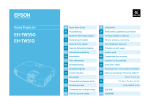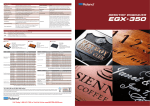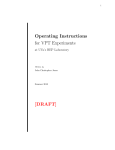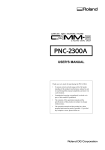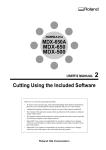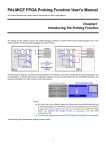Download zhs-man.
Transcript
Typesetting Chinese in XƎTEX:
zhspacing user’s manual∗
Yin Dian†
2012/03/14
Contents
I zhspacing.sty
3
1 Introduction
3
2 Getting Started
3
3 Advanced Usage
5
3.1
Fonts . . . . . . . . . . . . . . . . . . . . . . . . . . . .
5
3.2
More on Fonts . . . . . . . . . . . . . . . . . . . . . . .
7
3.3
Skips . . . . . . . . . . . . . . . . . . . . . . . . . . . .
7
3.4
Vertical Chinese . . . . . . . . . . . . . . . . . . . . . .
9
3.5
Compatibility . . . . . . . . . . . . . . . . . . . . . . .
10
3.6
Working with other Chinese package . . . . . . . . . .
10
4 Getting zhspacing
∗
†
11
Revision: 2012/03/14.
Lab. of Network Comm. System & Control, Univ. of Sci. & Tech. of China.
1
II zhfont.sty
11
1 Introduction
11
2 Package Options
12
3 Provided Macros
12
4 Examples
12
III
13
zhmath.sty
1 Introduction
13
2 Package Options
13
3 Provided Macros
14
4 Examples
15
2
File I
zhspacing.sty
1 Introduction
XƎTEX is a new TEX engine by Jonathan Kew and SIL International,
which combines ε-TEX with pervasive Unicode support and advanced
font support1 . Using XƎTEX, it is possible to typeset scripts of any
languages whose glyphs are contained in the font in use, without the
help of any extra packages, such as CJK2 .
However, XƎTEX itself does not solve all the problems. Some
details in Chinese typesetting have not been dealt with by XƎTEX, such
as the automatic font switch between Chinese and Western characters,
the skip adjustment of fullwidth punctuations, the automatic skip
insertion between Chinese and Western characters or math formulas,
etc.
To meet the need of easy and high quality typesetting of Chinese
documents using XƎTEX, the package zhspacing is coded, utilizing
the new primitive of \XeTeXinterchartoks provided in XƎTEX version 0.997.
2 Getting Started
zhspacing can be used in both plain XƎTEX or XƎLATEX. The usage
is quite straightforward. For instance, in plain XƎTEX,
\input zhspacing.sty
\zhspacing
这是中文测 试。中文和English的混排。中
文和$E=mc^2$的混排。
\bye
1
Words copied from the ConTeXt Wiki.
CJK is a LaTeX 2e macro package which enables the use of CJK scripts (Chinese/Japanese/Korean) in various encodings, written by Werner Lemberg.
2
3
And in XƎLATEX,
\documentclass{article}
\usepackage{zhspacing}
\zhspacing
\begin{document}
这是中文测 试。中文和English的混排。中
文和$E=mc^2$的混排。
\end{document}
Both of the examples above produce the same result as follows,
这是中文测试。中文和 English 的混排。中文和 E = mc2 的混排。
As you can see, spaces after Chinese characters are always ignored. Moreover, a noticable skip is inserted between Chinese characters and English characters as well as math formulas. In fact, all
of the following inputs can produce mixed langauge output with skip
automatically inserted between Chinese and English characters,
中Eng文,
中 Eng文, 中Eng 文
and
中 Eng 文.
And their corresponding output is,
中 Eng 文, 中 Eng 文,
中 Eng 文
and
中 Eng 文.
Look close and you’ll find, that the first and second input generates exactly the same output, and so does the third and fourth.
However, the skip between Eng and 文 in the last two cases is wider
than the skip between 中 and Eng. That is because the space is produced by the space token after the letter g, not the skip automatically
inserted by zhspacing’s skip mechanism.
The space ignoring and skip auto-inserting ability of zhspacing
can make writing documents much comfortable. You don’t need to
worry about the manual insertion of skips such as adding the annoying
~ in CJK.
Now come to the topic of punctuation skip adjustment. Proper
Chinese typesetting requires consecutive fullwidth punctuations be
compressed, and a linebreak before or after a fullwidth punctuation
will cut off the blank spaces of this punctuation, making it align to
the margin. zhspacing does have solved these problems, as well as
proper prohibitions(禁则). Here’s an example.
4
他强调,
“三个代表”重要思想是在新的历史条件
下运用马克思主义的立场、观点和方法的典范,
是我们学习马克思主义的立场、观点和方法最现
实、最生动的教材。
“三个代表”重要思想是与时
俱进的理论。
3 Advanced Usage
3.1 Fonts
zhspacing uses an extensible way of selecting fonts. The rules can be
summarized as follows,
• Western characters, i.e. those that are not CJKV ideographies
nor CJKV punctuations, use the same font as default.
• Chinese characters use seperate fonts. Font changes in the document does not affect the font used to display Chinese, unless
you are using NFSS and change the font series or shape.
• On displaying basic Chinese ideographies, execute the command
\zhfont.
• On displaying Chinese punctuations, execute the command
\zhpunctfont.
• On displaying CJK Ext-A characters, execute the command
\zhcjkextafont.
• On displaying CJK Ext-B characters, execute the command
\zhcjkextbfont.
• When switching from non-Chinese characters to Chinese characters, execute \zhs@savefont. When switching back, execute
\zhs@restorefont.
When importing zhspacing from plain XƎTEX, the default definitions of the above commands are,
5
\font\zhfont="SimSun" at 10pt
\font\zhpunctfont="SimSun" at 10pt
\def\zhcjkextafont{\message{CJK Ext-A}}
\def\zhcjkextbfont{\message{CJK Ext-B}}
\let\zhs@savefont=\begingroup
\let\zhs@restorefont=\endgroup
When imported from XƎLATEX, the defaults are,
\newfontfamily\zhfont[BoldFont=SimHei]{SimSun}
\newfontfamily\zhpunctfont{SimSun}
\def\zhcjkextafont{\message{CJK Ext-A}}
\def\zhcjkextbfont{\message{CJK Ext-B}}
\def\zhs@savefont{\zhs@savef@nt{old}}
\def\zhs@restorefont{\zhs@restoref@nt{old}}
Here \zhs@savef@nt and \zhs@restoref@nt are internal macros to
save and restore the NFSS info of the current font to specified places.
CJK Ext-A/B fonts have not been defined by default in consideration that not every user has installed the particular fonts. I recommend to use Sun-ExtA and Sun-ExtB as the corresponding fonts.
You can define the ext-font macros manually in a similar way to the
definition of \zhfont.
An example of mixed typesetting of various classes of characters
is as follows, cited from The Tale of Kiều3 .
𤾓𢆥𥪝𡎝𠊛些 Trăm năm, trong cõi người ta, 𡨸才𡨸
命𡑛罗恄𠑬 Chữ tài, chữ mệnh, khéo là ghét nhau.
𣦆戈𠬠局𣷭橷 Trải qua một cuộc bể dâu, 仍條𥉩𧡊
𦓡𤴬疸𢚸 Những điều trông thấy mà đau đớn lòng. 4
3
《金云翘传》,or Truyện Kiều, a Vietnamese lục bát poem written in chữ Nôm.
Chữ Nôm is a system of ideographies created by the Vietnamese laboring people,
most of which are encoded in CJK Ext-A/B area, or not even included in Unicode.
4
Some of the ideographies are replaced by similar characters due to the limitation of character set. A picture of the original manuscript can be found at this
link.
6
3.2 More on Fonts
Sometimes it may be desirable to use different Chinese fonts for different NFSS font families in LATEX. This can be done by changing
the definition of \zhs@savefont and \zhfont, without modifying the
zhspacing source.
Here is the way to do it.5
\makeatletter
\g@addto@macro\zhs@savefont{%
\long\edef\zhs@tmpmacro{\f@family}%
\def\zhs@curr@fam{0}%
\ifx\zhs@tmpmacro\sfdefault
\def\zhs@curr@fam{1}%
\else\ifx\zhs@tmpmacro\ttdefault
\def\zhs@curr@fam{2}%
\fi\fi
\edef\zhs@tmpmacro{\f@family}%
\ifx\zhs@tmpmacro\sfdefault
\def\zhs@curr@fam{1}%
\else\ifx\zhs@tmpmacro\ttdefault
\def\zhs@curr@fam{2}%
\fi\fi
}
\newfontfamily\zhrmfont[BoldFont=SimHei,
ItalicFont=KaiTi]{SimSun}
\newfontfamily\zhsffont{SimHei}
\newfontfamily\zhttfont[BoldFont=SimHei]{KaiTi}
\def\zhfont{\ifcase\zhs@curr@fam\zhrmfont\or\zhsffont
\or\zhttfont\else\zhrmfont\fi}
3.3 Skips
The skip mechanism in zhspacing is also flexible. zhspacing utilizes
the following skip commands. Note that they are defined as macros
instead of skip register values, in order that the skip varies according
to font size changes.
5
See zhfont.sty later for convenient ways.
7
\skipzh Skip between adjacent Chinese characters.
\skipenzh Skip between a Chinese character and a Western character
or a math formula.
\skipzhopen Skip before fullwidth opening punctuations, such as
““”, “(”, “《”, etc.
\skipzhinteropen Skip before a fullwidth opening punctuation when
preceded by another fullwidth punctuation.
\skipzhlinestartopen Skip before a fullwidth opening punctuation
when it occurs at the start of a line.
\skipzhclose Skip after fullwidth closing punctuations, such as “””,
“)”, “》”, etc.
\skipzhinterclose Skip after a fullwidth closing punctuation when
followed by another fullwidth punctuation.
\skipzhlineendclose Skip after a fullwidth closing punctuation
when it occurs at the end of a line.
\skipzhfullstop Skip after fullwidth fullstop punctuations, such as
“;”, “.”, “。”, etc.
\skipzhinterfullstop Skip after a fullwidth fullstop punctuation
when followed by another fullwidth punctuation.
\skipzhlineendfullstop Skip after a fullwidth fullstop punctuation
when it occurs at the end of a line.
\skipzhhalfstop Skip after fullwidth halfstop punctuations, such as
“、”, “,”, “:”, etc.
\skipzhinterhalfstop Skip after a fullwidth halfstop punctuation
when followed by another fullwidth punctuation.
\skipzhlineendhalfstop Skip after a fullwidth halfstop punctuation when it occurs at the end of a line.
\skipnegzhlinestartopen Negative skip to \skipzhlinestartopen.
8
\skipnegzhlineendclose Negative skip to \skipzhlineendclose.
\skipnegzhlineendfullstop Negative skip to \skipzhlineendfullstop.
\skipnegzhlineendhalfstop Negative skip to \skipzhlineendhalfstop.
All of the skip commands above are defined in the pattern
\def\skipxxx{\hskip xxxxx}.
zhspacing comes with three pre-defined skip schemes, namely
\simsunskipscheme, \emptyskipscheme and \haltskipscheme. The
first scheme should be suitable for font SimSun and other popular Chinese fonts used in China, which does not support OpenType features
of halt, and needs negative spaces be inserted before opening punctuations and after closing or judou punctuations. The second scheme
simply addes zero length. And the last one should be fit for OpenType
Chinese fonts supporting halt feature such as Adobe Song Std, where
positive spaces should be inserted before or after certain punctuations.
You can define your own skip schemes for customization, of course.
3.4 Vertical Chinese
我是中
Vertical Chinese can be achieved by adding raw feature vertical to
the specified font. An example could be,
我
\documentclass[12pt]{article}
\usepackage{graphicx}
\usepackage{zhspacing}
\zhspacing
\begin{document}
\newfontfamily\zhfont[
RawFeature={script=hani:language=CHN:vertical:+vert}]{SimSun}
\let\zhpunctfont\zhfont
\haltskipscheme
\rotatebox{-90}{我是中国人,我爱自己的祖国。}
\end{document}
的
Note that in this example, in order to have proper vertical punctuations, we set \zhpunctfont to use the Adobe one supporting vert
9
feature, and change the skip scheme to \haltskipscheme to match
the vhal feature specified.
However, there exists some bug in typesetting vertical Chinese
containing punctuations using some fonts such as KaiTi_GB2312 etc.
I’ve told this bug to jjgod in May, but it seems that he hasn’t solved
the problem yet. Moreover, the baseline of vertical Chinese is not
correct, so mixed typesetting of Chinese and English in vertical mode
generates ugly results, and thus should be avoided.
3.5 Compatibility
Theoretically, zhspacing should be compatible with all macro packages, except those who change the definition of \hskip and \penalty,
in which case special treatment should be applied. I haven’t
found any conflict when using common packages such as hyperref
and fancyhdr. However, ulem redefineds \hskip and \penalty,
and causes unexpected output6 . Use zhulem provided along with
zhspacing instead.
zhspacing may be not compatible with macro packages which
use \XeTeXinterchartoks faculty. For example, the polyglossia
package (some languages).
3.6 Working with other Chinese package
zhspacing is not compatible with xeCJK. The latter can be only used
in LATEX format. zhspacing is now supposed to be mainly used in
Plain TEX format; in LATEX, xeCJK is a better choice.
The ctex package, made by ctex.org, is a widely used Chinese
document framework which hides the underlying Chinese processing
6
I was using \begingroup and \endgroup as the font saving/restoring commands. However, I found ulem redefines \hskip and \penalty to end the current
hbox group and start a new hbox, and thus group mismatch occurs. So I changed
the font saving/restoring commands when used in LATEX, using NFSS info instead
of groups. But in the new hbox group, no Chinese font is applied by default so
the Chinese characters disappears. Therefore I changed the definitions of ulem’s
new \hskip and \penalty in zhulem, and advice users to use this modified one.
10
details to the user, which enables portability between different Chinese
processing packages or systems. New version of ctex package supports
XƎTEX through xeCJK package, zhspacing is not necessary.
To use zhspacing in cxetex, a slight modification of the file
ctexcjk.clo should be made. Change the corresponding lines to the
followes (% means the original lines).
%\XeTeXlinebreaklocale "zh"
%\XeTeXlinebreakskip = 0pt plus 1pt minus 0.1pt
%\setmainfont[BoldFont={cwTeXHeiBold},
%
ItalicFont={cwTeXKaiItalic},
%
Mapping=tex-text]{cwTeXMing}
%\setsansfont[BoldFont={cwTeXHeiBold},Mapping=tex-text]{cwTeXYen}
%\setmonofont{cwTeXFangSongTT}
\usepackage{zhspacing}
\newfontfamily\zhfont[BoldFont=SimHei]{SimSun}
\newfontfamily\zhcjkextafont{Sun-ExtA}
\newfontfamily\zhcjkextbfont{Sun-ExtB}
\zhspacing
You can surely change these lines to your own taste.
4 Getting zhspacing
You can get latest stable version of zhspacing on CTAN.
zhspacing was hosted on an open-source project at googlecode. The old project homepage is http://code.google.com/p/
zhspacing/.
Now zhspacing is part of ctex- kit project (http://code.
google.com/p/ctex-kit/). You can get the lastest source via SVN.
11
File II
zhfont.sty
1 Introduction
To simplify the complex font setting to use NFSS in LATEX, the package
zhfont is coded. It also adds simple interface to define fonts with fake
slant, and also supports fake bold.
2 Package Options
zhfont currently has only one option — fakebold. This option sets
Chinese show fake boldface when the current series is bold.
3 Provided Macros
•\zhrmfont
•\zhsffont
•\zhttfont
The font commands to be executed according to the current font
family. You can redefine them to customize your fonts.
•\setzhmainfont
•\setzhsansfont
•\setzhmonofont
Simply macro to set \zh{rm/sf/tt}font using \newfontfamily.
•\newfontfamilywithslant
Create a font family with fake slant. Take one argument as the
font name.
Example: \newfontfamilywithslant\zhrmfont{SimSun}
•\newfontfamilywithslantandbold
Create a font family with fake slant, and specify another font
for its boldface. Take two arguments as the font name and bold font
name.
Example:
\newfontfamilywithslantandbold\zhrmfont{SimSun}{SimHei}
12
4 Examples
The following example is generated with zhfont loaded with option
fakebold.
\newfontfamilywithslant\zhrmfont{SimSun}
中文\textbf{测试}。\textit{中文\textbf{测试}。}
\newfontfamilywithslant\zhrmfont{FangSong}
中文\textbf{测试}。\textit{中文\textbf{测试}。}
中文测试。中文测试。 中文测试。中文测试。
File III
zhmath.sty
1 Introduction
zhmath is a generic package which allows the Chinese characters to
be displayed in math formulas. It also allows changing the math font
for alphas and numbers.
zhmath only sets the basic Chinese characters to be displayable,
not CJK Ext-A/B ones, as they are seldom used and discouraged in
math. You can use \hbox to let zhspacing display them, however.
2 Package Options
In LATEX, zhmath has two options — active and noactive. They set
the method to implement Chinese character displaying in math. The
default is noactive.
When active is set, the Chinese characters in math formulas
are set to active, which, when executed, display the corresponding
characters in \zhmathfont. This behavior is much like that of the
13
package mathcjk. The font size in different styles are also set in
\mathcjksizea/b/c/d.
When noactive is set, the mathcodes of Chinese characters are
set to use a special math font family to display them. This way is
more native than to use active characters.
Both active and noactive have disadvantages. In active mode
the Chinese math font sizes are determined by \mathcjksizea/b/c/d,
so they are somewhat independent with the main text size, which
means their size cannot change when the main font size changes,
which gives ugly results. However, in noactive mode, although Chinese math font size varies with the main font size, Chinese inside
\mathrm etc cannot be displayed, because the math font family are
set to \mathrm’s. So choose the option to your own need.
In plain TEX no package options are available.
3 Provided Macros
•\setzhmathfont
Set the math font used to display Chinese. Take one argument
as the font command. Preamble only.
•\zhmathfont
The font command which determines the math font for Chinese. However, if you use noactive option in LATEX, or you’re
in plain TEX, they are not executed when Chinese in math occur,
but when \setzhmathfont is invoked. So you should always call
\setzhmathfont\zhmathfont after the change.
•\usecustommathfonts
Enable the use of custom math fonts for alphas and numbers.
The default is Times New Roman.
•\setalphanummathfonts
Set the math font used to display alphas and numbers. Preamble only. Take one argument as the font family in LATEX, and two
argument as the font command for alphas and numbers accordingly
in plain TEX.
14
•\zhmathalphanumfont
The font command which determines the math font for alphas
and numbers in LATEX. Should always call \setalphanummathfonts
\zhmathalphanumfont after it changes.
•\zhmathletterfont
•\zhmathnumberfont
The font command which determines the math font for alphas and
numbers in plain TEX. After their change \setalphanummathfonts
with corresponding arguments should be called.
4 Examples
{
$中文 in math 测_试$
\usecustommathfonts
\Large $能量E = mc^2$, $s_总 = {1 \over 2} at^2$
}
中文inmath测试
能量E = mc2, s总 = 21 at2
15

















